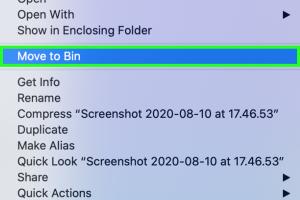Mastering File Management: 2 Simple Steps to Delete Read Only Files

-
Quick Links:
- Introduction
- Understanding Read-Only Files
- Step 1: Remove the Read-Only Attribute
- Step 2: Deleting the File
- Case Studies
- Expert Insights
- Best Practices for File Management
- FAQs
- Conclusion
Introduction
Managing files on your computer can sometimes feel like navigating a labyrinth, especially when you encounter read-only files. These types of files can be frustrating when you need to make changes or delete them altogether. In this comprehensive guide, we’ll break down the process into two simple steps that anyone can follow, regardless of their tech-savviness. Let’s dive in!
Understanding Read-Only Files
Read-only files are designed to prevent accidental modification or deletion. This is particularly useful for important documents, such as templates or system files. However, there are times when you might need to delete these files. Understanding how to manage these file attributes is crucial for efficient file management.
What Causes Files to be Read-Only?
- File Permissions: Certain files are set to read-only by their creators or system settings.
- Software Behavior: Some applications automatically save files as read-only to protect original versions.
- External Drives: Files transferred from external devices may inherit read-only attributes.
Step 1: Remove the Read-Only Attribute
The first step in deleting a read-only file is to remove its read-only attribute. Here’s how you can do that on both Windows and Mac systems.
For Windows Users
- Right-click on the read-only file.
- Select Properties.
- In the General tab, uncheck the Read-only box.
- Click Apply, then OK.
For Mac Users
- Right-click on the read-only file and select Get Info.
- In the Sharing & Permissions section, click the lock icon to unlock it.
- Enter your admin password.
- Change the permission for your user account to Read & Write.
Step 2: Deleting the File
Now that the read-only attribute has been removed, you can proceed with deleting the file. Here's how to do it on both platforms:
For Windows Users
- Locate the file in Windows Explorer.
- Select the file and press the Delete key on your keyboard or right-click and select Delete.
- Confirm the deletion if prompted.
For Mac Users
- Open Finder and locate the file.
- Drag the file to the Trash or right-click and select Move to Trash.
- Empty the Trash to permanently delete the file.
Case Studies
Understanding the practical implications of deleting read-only files can help reinforce the importance of file management. Here are a couple of examples:
Case Study 1: A Graphic Designer’s Dilemma
A graphic designer realized that several important templates were saved as read-only, preventing updates. By following the steps outlined above, they quickly regained access and updated their files, ensuring they could meet client deadlines.
Case Study 2: IT Department Challenges
An IT department faced a situation where system files were marked as read-only, causing issues during software updates. By removing the read-only attribute, they successfully completed the updates without further complications.
Expert Insights
We spoke with file management specialists to gather their insights on best practices for handling read-only files:
"Always ensure you back up important files before changing attributes. This way, you can recover data in case of mistakes." - Jane Doe, File Management Expert
"Educating users about file permissions can prevent many issues related to read-only files." - John Smith, IT Consultant
Best Practices for File Management
- Regularly audit your files to identify any read-only files that may need updates.
- Implement a structured naming convention to reduce confusion.
- Educate team members about the implications of file permissions.
- Utilize file recovery tools to ensure data is not lost during deletions.
FAQs
1. What is a read-only file?
A read-only file is a file that cannot be modified or deleted without changing its attributes.
2. Why would a file be set to read-only?
Files can be set to read-only for various reasons, including protecting important data from accidental changes.
3. Can I recover deleted read-only files?
Yes, you can recover deleted files using specialized file recovery software, as long as they haven’t been overwritten.
4. How do I know if a file is read-only?
You can check the properties of a file to see if the read-only attribute is enabled.
5. Is it safe to delete read-only files?
It is safe to delete read-only files if you are sure they are not needed.
6. What happens if I delete a read-only file?
Deleting a read-only file removes it from your system, making it unrecoverable unless you have backups.
7. Can I change a read-only file back to editable?
Yes, you can change a read-only file back to editable by removing the read-only attribute.
8. Are there any software tools to manage file permissions?
Yes, there are several software tools available that can help you manage file permissions more effectively.
9. What if I cannot remove the read-only attribute?
If you're unable to remove the read-only attribute, ensure you have the necessary permissions or check if the file is in use by another application.
10. Can read-only files be shared with others?
Yes, you can share read-only files, but others will not be able to edit them unless they change the permissions.
Conclusion
Deleting read-only files may seem daunting at first, but with these two simple steps, you can effectively manage your files without hassle. Remember to always back up important files and educate yourself about file permissions for better management in the future. Now that you have the tools and knowledge at your disposal, take control of your file management today!
External References
- How to Remove the Read-Only Attribute in Windows 10
- Manage Permissions in Mac OS X
- How to Recover Deleted Files
Random Reads